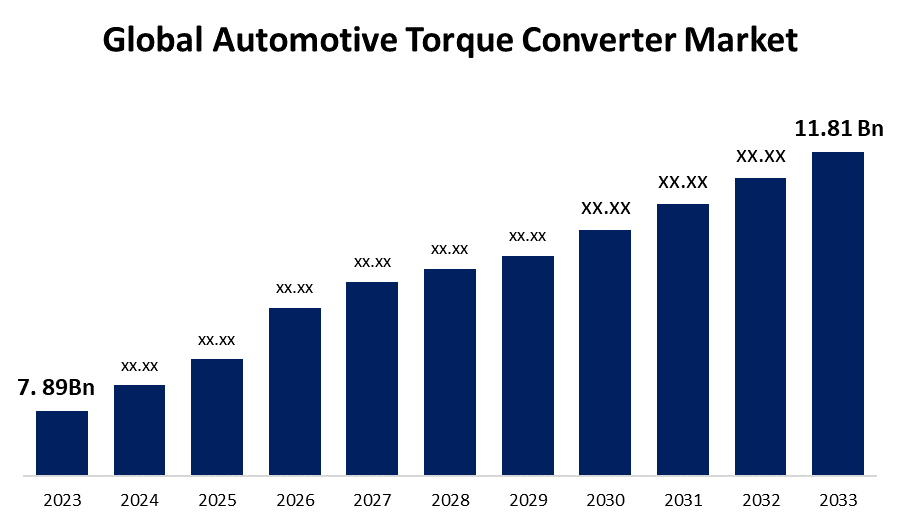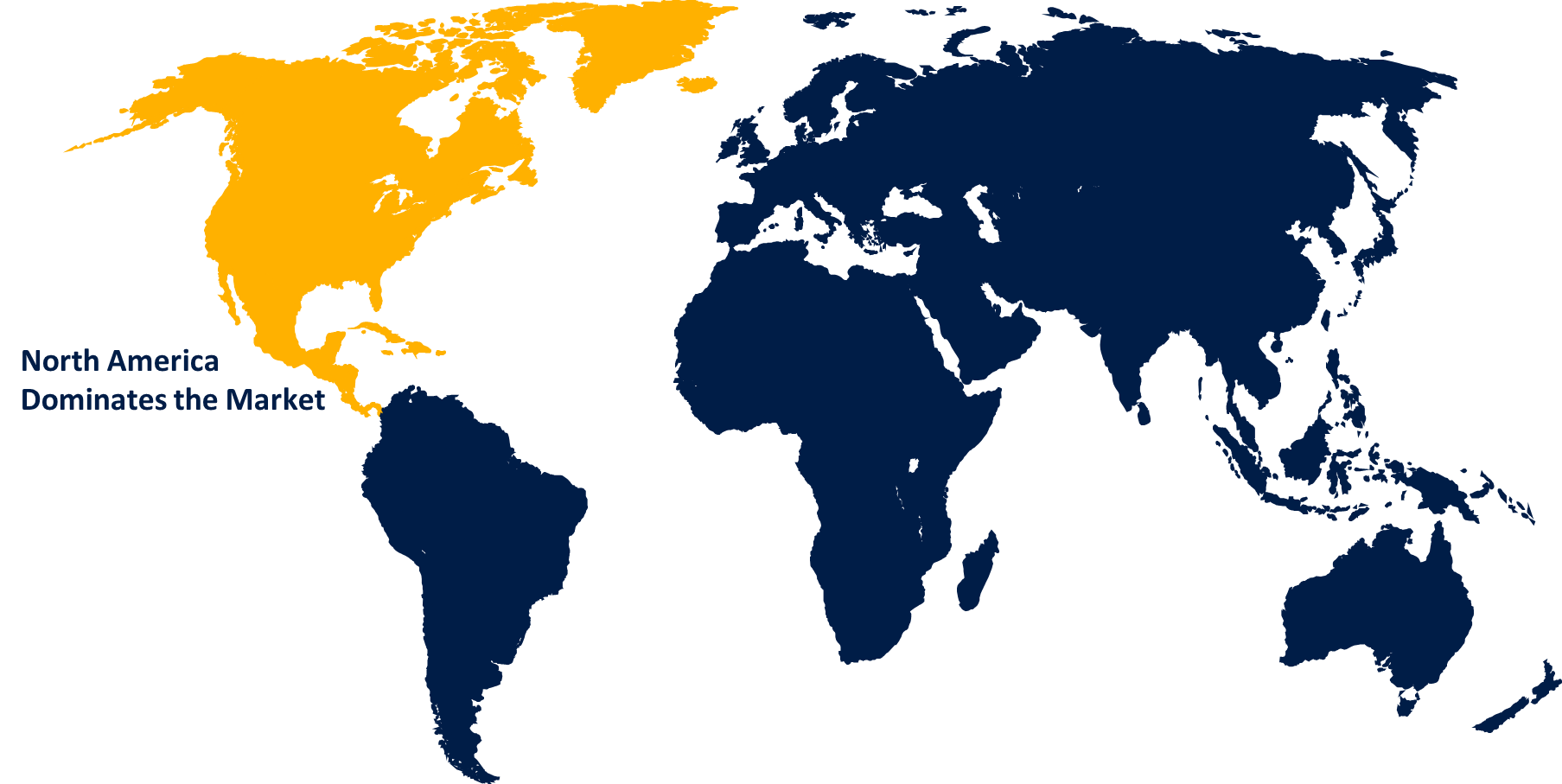Global Automotive Torque Converter Market Size, Share, and COVID-19 Impact Analysis, By Type (Continuously Variable Transmission, Automatic Transmission and Dual-Clutch Transmission), By Vehicle Type (Passenger Vehicle, and Commercial Vehicle), By Electric Vehicle (BEV, Plug-In Hybrid Electric Vehicle and Hybrid Electric Vehicle), and By Region (North America, Europe, Asia-Pacific, Latin America, Middle East, and Africa), Analysis and Forecast 2023 - 2033
Industry: Automotive & TransportationGlobal Automotive Torque Converter Market Insights Forecasts to 2033
- The Global Automotive Torque Converter Market Size was Valued at USD 7.89 Billion in 2023
- The Market Size is Growing at a CAGR of 4.12% from 2023 to 2033
- The Worldwide Automotive Torque Converter Market Size is Expected to Reach USD 11.81 Billion by 2033
- Asia Pacific is Expected to Grow the fastest during the forecast period.

Get more details on this report -
The Automotive Torque Converter Market Size is Anticipated to Exceed USD 11.81 Billion by 2033, Growing at a CAGR 4.12% from 2023 to 2033.
Market Overview
A torque converter is a device that provides rotational power from an energy source, such as an internal combustion engine, to a rotating driving weight. It is typically implemented as a sort of fluid coupling. The torque converter in an automatic gearbox car links the primary engine to the automatic gear train, which powers the load. The clutch that separates the transmission from the engine is absent from cars with automated transmissions. Rather, they utilize the use of an apparatus known as a torque converter. Thus, a torque converter is typically situated between the transmission and the flex plate of the engine. The mechanical clutch in a manually operated transmission is the corresponding component. A form of fluid coupling that permits the engine to spin relatively independently of the transmission is a torque converter. Minimal torque is transferred through the torque converter while the engine is running slowly, as when the automobile is stopped at a stoplight, so minimal brake pedal pressure is needed to keep the vehicle stationary. Future applications for automotive torque converters include increased fuel economy, more effective vehicle performance, and support for the integration of electric vehicles (EVs), smoother power transfer in hybrid systems, and the advancement of autonomous driving technology through the provision of dependable and adaptable power management solutions. Furthermore, torque converters are developing lightweight torque converters for integration with electric and hybrid transmissions.
Report Coverage
This research report categorizes the market for the automotive torque converter market based on various segments and regions forecasts revenue growth and analyzes trends in each submarket. The report analyses the key growth drivers, opportunities, and challenges influencing the automotive torque converter market. Recent market developments and competitive strategies such as expansion, product launch, and development, partnership, merger, and acquisition have been included to draw the competitive landscape in the market. The report strategically identifies and profiles the key market players and analyses their core competencies in each sub-segment of the automotive torque converter market.
Automotive Torque Converter Market Report Coverage
| Report Coverage | Details |
|---|---|
| Base Year: | 2023 |
| Market Size in 2023: | USD 7.89 Billion |
| Forecast Period: | 2023 - 2033 |
| Forecast Period CAGR 2023 - 2033 : | 4.12% |
| 2033 Value Projection: | USD 11.81 Billion |
| Historical Data for: | 2019-2022 |
| No. of Pages: | 243 |
| Tables, Charts & Figures: | 110 |
| Segments covered: | By Type, By Vehicle Type, By Electric Vehicle, By Region |
| Companies covered:: | Dynamic Manufacturing, Stewart & Stevenson, Raybestos Powertrain, LLC, Schaeffler Technologies AG & Co. KG, Magtorq Pvt. Ltd., Aisin Seiki Corporation, BorgWarner Inc., Allison Transmission Holdings, Inc., Fuji Machinery Co., Ltd., Sonnax Industries Inc., Precision Industries, Delphi Technologies, Exedy Corporation, Jatco, and Others |
| Pitfalls & Challenges: | Covid 19 Impact Challanges, Future, Growth and Analysis |
Get more details on this report -
Driving Factors
Increasing demand for fuel efficiency
The growing sales of premium sector vehicles and the increasing use of automatics in mid-segment vehicles are the main drivers propelling the market's expansion. Due to its direct effect on total vehicle performance and economy, the increased need for fuel efficiency is a major driver of the automotive torque converter industry. Automakers are under pressure to increase vehicle economy as environmental concerns and fuel prices become more important to consumers and regulators.
Restraining Factors
High Cost of Repairs
Several factors, including the high cost of repairs, limited component availability, and the growing prevalence of automated manual transmission are impeding the growth of the torque converter industry.
Market Segmentation
The automotive torque converter market share is classified into type, vehicle type, and electric vehicle.
- The dual-clutch transmission segment accounted for the largest revenue share over the forecast period.
Based on the type, the automotive torque converter market is categorized into continuously variable transmission, automatic transmission, and dual-clutch transmission. Among these, the dual-clutch transmission segment accounted for the largest revenue share over the forecast period. Dual-clutch transmission (DCTs) utilize two distinct clutches for both odd and even gear sets, enabling faster and more effective gear shifts than typical automatic transmissions. Torque converters in DCT devices are essential for maintaining smooth power transmission and gearbox transitions. DCTs are prominent in performance vehicles and high-end passenger automobiles because of their ability to provide quick acceleration and increased fuel efficiency.
- The passenger vehicle segment is anticipated to grow at the highest CAGR during the forecast period.
Based on the vehicle type, the automotive torque converter market is categorized into passenger vehicle and commercial vehicle. Among these, the passenger vehicle segment is anticipated to grow at the highest CAGR during the forecast period. The passenger vehicle market contains a diverse range of vehicles, comprising sedans, hatchbacks, SUVs, and luxury vehicles. Torque converters perform an important function in passenger vehicles by enabling smooth and seamless power transfer, increasing driving comfort, and improving fuel efficiency.
- The hybrid electric vehicle segment holds the highest market share through the forecast period.
Based on the electric vehicle, the automotive torque converter market is categorized into BEV, plug-in hybrid electric vehicle, and hybrid electric vehicle. Among these, the hybrid electric vehicle segment holds the highest market share through the forecast period. In hybrid electric vehicles (HEVs), torque converters enhance both performance and fuel efficiency. HEVs deliver a desirable combination of fewer emissions and greater range without the need for regular recharging, which is appealing to consumers and automakers that prioritize sustainability and fuel efficiency.
Regional Segment Analysis of the Automotive Torque Converter Market
- North America (U.S., Canada, Mexico)
- Europe (Germany, France, U.K., Italy, Spain, Rest of Europe)
- Asia-Pacific (China, Japan, India, Rest of APAC)
- South America (Brazil and the Rest of South America)
- The Middle East and Africa (UAE, South Africa, Rest of MEA)
North America is anticipated to hold the largest share of the automotive torque converter market over the predicted timeframe.

Get more details on this report -
North America is projected to hold the largest share of the automotive torque converter market over the forecast period. North America, particularly the United States, has a well-established automotive industry that includes advanced manufacturing facilities, a robust supply chain, and leading automotive OEMs. This infrastructure allows for extensive research and development, supporting innovation in automobile technology like torque converters. The presence of major automakers and gearbox manufacturers in the region encourages widespread adoption of current torque converter technology, which improves vehicle performance and fuel efficiency. Furthermore, severe fuel economy and pollution regulations in North America force automakers to adopt efficient torque converters to meet these criteria. Furthermore, increased demand for passenger and commercial vehicles, combined with consumer preference for automatic transmissions, fuels growth in the torque converter business.
Asia Pacific is expected to grow at the fastest CAGR growth in the automotive torque converter market during the forecast period. In China and India, the automotive torque converter market is expanding rapidly. As these countries continue to see strong economic growth, an expanding middle class, and more urbanization, there is a growing demand for vehicles. Furthermore, restricted pollution rules encourage the use of modern torque converters, notably in hybrid and electric vehicles. These factors, combined with changing customer tastes, are important growth drivers in the Asia-Pacific vehicle torque converter market.
Competitive Analysis:
The report offers the appropriate analysis of the key organizations/companies involved within the automotive torque converter market along with a comparative evaluation primarily based on their product offering, business overviews, geographic presence, enterprise strategies, segment market share, and SWOT analysis. The report also provides an elaborative analysis focusing on the current news and developments of the companies, which includes product development, innovations, joint ventures, partnerships, mergers & acquisitions, strategic alliances, and others. This allows for the evaluation of the overall competition within the market.
List of Key Companies
- Dynamic Manufacturing
- Stewart & Stevenson
- Raybestos Powertrain, LLC
- Schaeffler Technologies AG & Co. KG
- Magtorq Pvt. Ltd.
- Aisin Seiki Corporation
- BorgWarner Inc.
- Allison Transmission Holdings, Inc.
- Fuji Machinery Co., Ltd.
- Sonnax Industries Inc.
- Precision Industries
- Delphi Technologies
- Exedy Corporation
- Jatco
- Others
Key Target Audience
- Market Players
- Investors
- End-users
- Government Authorities
- Consulting And Research Firm
- Venture capitalists
- Value-Added Resellers (VARs)
Recent Developments
- In December 2023, Circle D Specialties, a manufacturer of high-performance torque converters and driveline components for the automotive aftermarket, officially confirmed its lucrative acquisition of Reid Racing.
- In January 2022, Schaeffler's iTC torque converter represents an individually new generation of lightweight, vibration-reducing components. A lock-up clutch integrated into the converter's turbine is a major element of the TC, or 'integrated torque converter,' as it is officially known. This not only lightens the system but also allows for more efficient torsion dampers, including a centrifugal pendulum absorber.
- In 2022, Volkswagen introduced the Virtus, which comes with two gasoline engine options, in India. A 6-speed torque converter automatic transmission or a 6-speed manual transmission can be used with the 1.0-liter turbocharged gasoline engine, which generates 110 PS of power and 175 Nm of torque. The 1.5L turbo gasoline engine, on the other hand, produces 250 Nm of torque and 150 PS of power. It can come attached to either a 6-speed manual or a 7-speed dual-clutch automatic transmission.
Market Segment
This study forecasts revenue at global, regional, and country levels from 2020 to 2033. Spherical Insights has segmented the automotive torque converter market based on the below-mentioned segments:
Global Automotive Torque Converter Market, By Type
- Automatic Transmission
- Continuously Variable Transmission
- Dual-Clutch Transmission
Global Automotive Torque Converter Market, By Vehicle Type
- Passenger Vehicle
- Commercial Vehicle
Global Automotive Torque Converter Market, By Electric Vehicle
- BEV
- Plug-In Hybrid Electric Vehicle
- Hybrid Electric Vehicle
Global Automotive Torque Converter Market, By Regional Analysis
- North America
- US
- Canada
- Mexico
- Europe
- Germany
- UK
- France
- Italy
- Spain
- Russia
- Rest of Europe
- Asia Pacific
- China
- Japan
- India
- South Korea
- Australia
- Rest of Asia Pacific
- South America
- Brazil
- Argentina
- Rest of South America
- Middle East & Africa
- UAE
- Saudi Arabia
- Qatar
- South Africa
- Rest of the Middle East & Africa
Need help to buy this report?